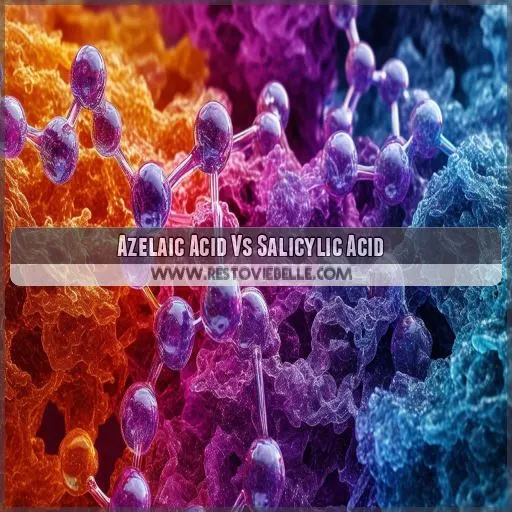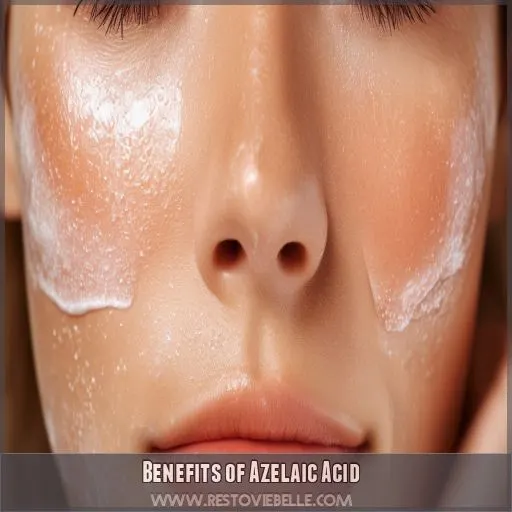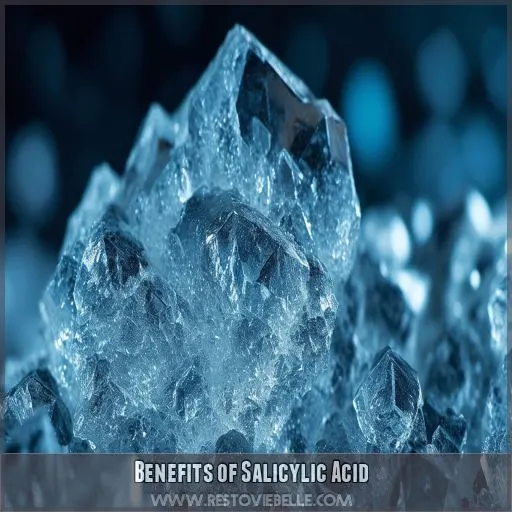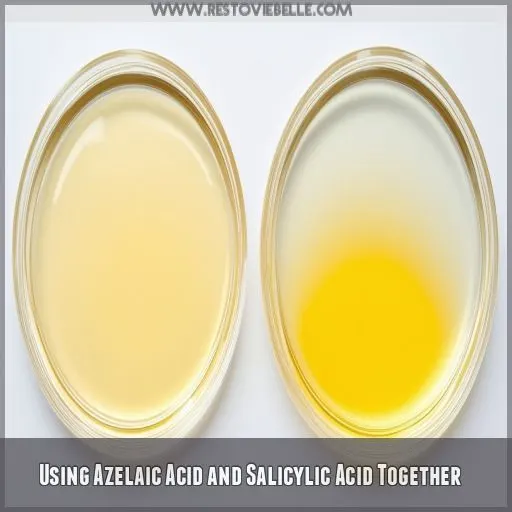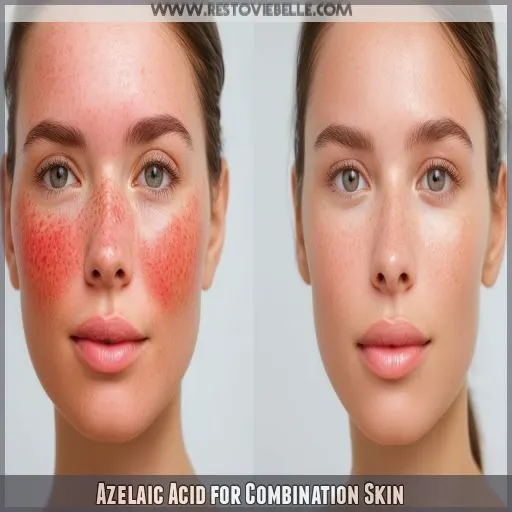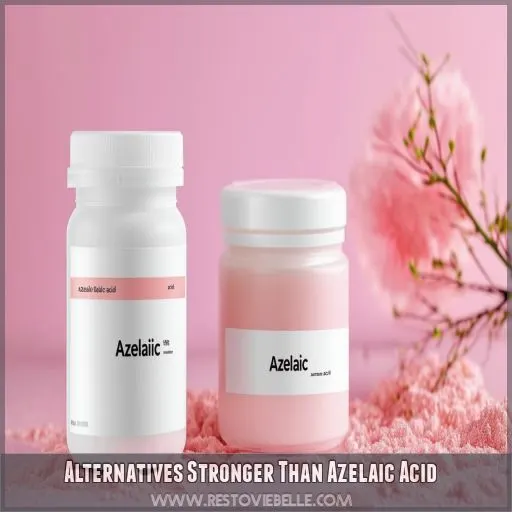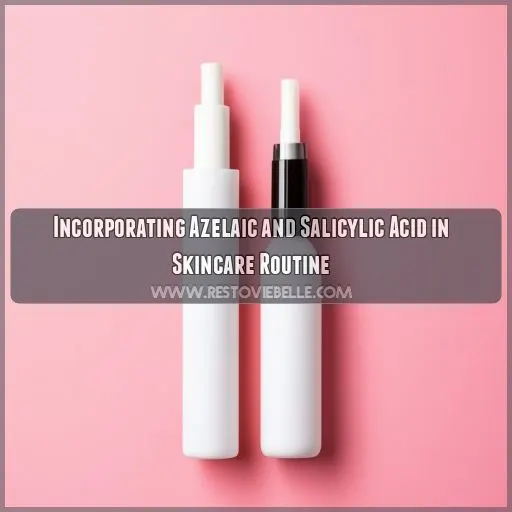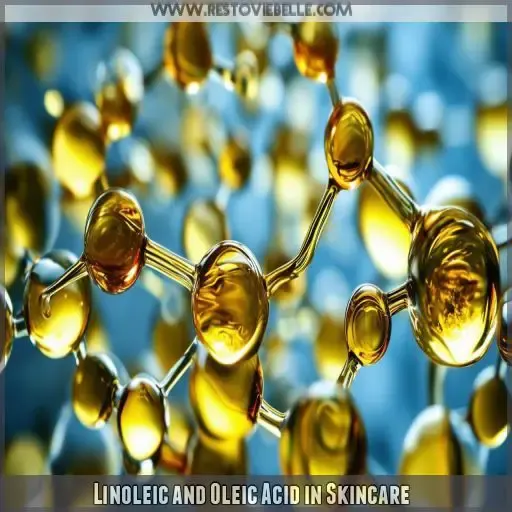This site is supported by our readers. We may earn a commission, at no cost to you, if you purchase through links.
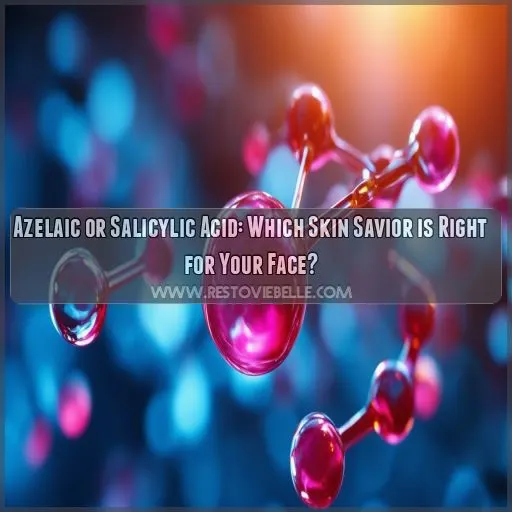
All of these have various benefits against different skin concerns. Azelaic acid works at fighting acne, evening out redness, and uneven skin tone.
This is where salicylic acid shines: in exfoliating and cleaning pores.
Understand what these ingredients specialize in and how they go together to create the best combination that will introduce you to the right fit for your skincare routine. Let’s dive into these powerhouse ingredients to find your ultimate skin savior.
Table Of Contents
- Key Takeaways
- Azelaic Acid Vs Salicylic Acid
- Benefits of Azelaic Acid
- Benefits of Salicylic Acid
- Using Azelaic Acid and Salicylic Acid Together
- Azelaic Acid for Combination Skin
- Alternatives Stronger Than Azelaic Acid
- Incorporating Azelaic and Salicylic Acid in Skincare Routine
- Linoleic and Oleic Acid in Skincare
- Frequently Asked Questions (FAQs)
- Which is better, salicylic acid or azelaic acid?
- Can I use azelaic acid and salicylic acid together?
- What is better than azelaic acid?
- Why not to use azelaic acid?
- How should I store azelaic acid products?
- Are there side effects of salicylic acid?
- Can azelaic acid be used during pregnancy?
- How long before I see results?
- What is the origin of salicylic acid?
- Conclusion
Key Takeaways
- Azelaic acid is a gentle giant that fights acne, evens out skin tone, and soothes rosacea, while salicylic acid is an exfoliating powerhouse that deep cleans pores and controls oil.
- Like a tag team, azelaic and salicylic acids work together to conquer acne, inflammation, and uneven skin tone, but tread carefully to avoid overdoing it.
- If azelaic acid isn’t strong enough for your stubborn dark spots, consider a discoloration-correcting serum or dark spot cream for a more targeted approach.
- Remember, skincare is a marathon, not a sprint. Patience and consistency with your azelaic or salicylic acid routine will lead you to a radiant, healthy complexion.
Azelaic Acid Vs Salicylic Acid
Probably on your skincare list are azelaic and salicylic acids, but the question is how much they hold up against each other. Azelaic acid is called upon if you’re looking to treat hyperpigmentation or dark spots. However, salicylic acid does its thing when it comes to exfoliation or cases of clogged pores, in which it tops.
It’s not that clear-cut, considering the efficacy depends on what your skin is looking for. Concentrations of ingredients also matter, with azelaic acid mostly found in higher percentages.
Against skin types, generally speaking, azelaic acid seems gentler and more easily tolerated by sensitive skin, whereas salicylic acid does better on oily types. Management of side effects is desirable in both; nevertheless, salicylic acid might turn out to be more drying.
Long-term effects? Both give very good results for improving skin texture, but azelaic acid has an edge when evening out skin tone.
Keep in mind that everyone’s skin is different, so if something works for your best friend, it doesn’t have to work on you too!
Benefits of Azelaic Acid
Azelaic acid offers multiple benefits for your skin, including effective acne control, impressive brightening effects, and relief from rosacea symptoms. This versatile ingredient can help clear up blemishes, even out your skin tone, and reduce redness, making it a powerful ally in your skincare routine.
Acne Control
Azelaic acid packs a powerful punch against acne. It’s both anti-inflammatory and antibacterial, tackling breakouts from multiple angles.
Unlike salicylic acid, which can lead to overexfoliation and dryness, azelaic acid is gentler on your skin. It keeps pores clear while moisturizing, making it a go-to for acne-prone faces.
You’ll love how it calms angry spots without leaving your skin feeling parched or irritated.
Brightening Effects
While tackling acne, you’ll be pleased to know that azelaic acid also works wonders for brightening your complexion. It’s a multitasking marvel that targets hyperpigmentation and evens out your skin tone.
By inhibiting melanin production, azelaic acid fades dark spots and discoloration, giving you that coveted glow.
Unlike harsh bleaching agents, it’s gentle enough for daily use, making it a go-to for those seeking a radiant, even-toned visage.
Rosacea Relief
If brightening’s not your top concern, azelaic acid‘s still got you covered. For those battling rosacea, it’s a game-changer. This multitasking marvel tackles inflammation and redness head-on, soothing your angry skin.
Unlike harsh treatments, azelaic acid’s gentle nature makes it perfect for sensitivity. It’s like a cool compress for your face, calming the storm of uneven skin tone.
Even if you’ve got combination skin, azelaic acid plays nice, balancing your complexion without overshadowing salicylic acid’s benefits.
Benefits of Salicylic Acid
Salicylic acid is a powerhouse for oily and acne-prone skin, working to unclog pores and reduce excess oil production. It’s particularly effective at tackling blackheads and whiteheads, as it can penetrate deep into pores to remove built-up debris and dead skin cells.
Exfoliation and Pore Cleansing
While azelaic acid offers multiple benefits, salicylic acid shines in exfoliation and pore cleansing. This powerhouse ingredient dives deep into your pores, sweeping away dead skin cells and excess oil. It’s like a tiny vacuum cleaner for your face, helping to:
- Reduce pore size appearance
- Prevent acne breakouts
- Promote skin renewal
Salicylic acid’s exfoliating effect works wonders for those pesky blackheads and whiteheads, leaving your skin smoother and clearer. It’s a game-changer for acne-prone skin!
Oil Control
While exfoliating your skin, salicylic acid also tackles excess oil like a pro. It’s a godsend for those battling the dreaded shine.
This BHA dives deep into your pores, regulating sebum production and keeping that unwanted oiliness at bay.
If you’re prone to acne or have naturally oily skin, salicylic acid might just be your new best friend.
Just be mindful of potential dryness – balance is key!
Blackhead Reduction
Blackheads got you down? Salicylic acid is the superhero your skin care routine needs.
This powerful ingredient dives deep into the pores to break up all that gunk that causes blackheads. It works not only on current blemishes but also prevents new ones from popping up in their places.
As if that weren’t enough, regular use can reduce pore size, making enlarged pores almost invisible and evening out acne scarring.
Hello, clearer, smoother skin!
Using Azelaic Acid and Salicylic Acid Together
You may use azelaic acid and salicylic acid together for better skincare results because they complement each other in fighting acne, inflammation, and uneven skin tone.
However, it’s important to implement them gradually and be observant of your skin’s response, as applying both acids at once could cause irritation or dryness on some individuals’ skin.
Complementary Effects
When you combine azelaic and salicylic acid, you really do get a dynamic duo on your skin. The antibacterial properties work well together to fight acne. Azelaic acid works on inflammation, while salicylic acid cleans out pores.
Working together, they can work magic on combination skin—all of the problems there get addressed.
Keep in mind, though, how important it is to make sure that you’re not damaging your skin barrier by overdoing the exfoliating. Bring it on slowly, and voilà—you’ll be well along the road to clearer, more balanced skin.
Potential Risks
While combining azelaic and salicylic acids can be a very powerful duo, there are risks associated with it. You’ll definitely need to tread with caution here to make sure you’re not overwhelming your skin. Here’s what to watch out for:
- Increased irritation and inflammation
- May cause overexfoliating and sensitivity
- Excessive dryness and flaking
- Unexpected reactions, especially if you have sensitive skin
Your skin’s tolerance may vary, so it’s crucial to introduce these acids gradually and monitor how your face responds to this potent pairing.
Proper Usage Guide
When combining azelaic and salicylic acids, start with a patch test to avoid side effects.
Use each acid in separate steps of your routine, applying serums before moisturizer. Begin with lower concentrations and gradually increase frequency.
Watch for signs of overexfoliation, like redness or dryness.
Always follow up with sun protection, as these acids can increase skin sensitivity.
Consider alternating days or using one in the morning and the other at night.
Azelaic Acid for Combination Skin
If you’re dealing with combination skin, azelaic acid can be your secret weapon. It’s great at balancing out oily and dry areas while also soothing redness, making it a versatile solution for your varied skin needs.
Balancing Oily and Dry Areas
If you’re dealing with combination skin, azelaic acid might be your new best friend. It’s a multitasker that can balance both oily and dry areas on your face.
Unlike harsh exfoliants, azelaic acid gently removes dead skin cells without over-drying. It also regulates sebum production in oily zones while providing light hydration to dry patches.
This versatile ingredient works well with both oleic and linoleic acids, making it a go-to for tricky combination skin.
Redness Soothing
Beyond balancing oily and dry areas, azelaic acid excels at soothing redness in combination skin. It’s a powerhouse for redness reduction, irritation relief, and inflammation calming.
If you’re dealing with rosacea or sensitive skin, azelaic acid can be your go-to treatment. Unlike harsh acids, it’s gentle enough for daily use.
Pair it with hydration to maximize benefits and tackle age spots caused by melanin overproduction.
Alternatives Stronger Than Azelaic Acid
If you’re looking for stronger alternatives to azelaic acid, consider trying a discoloration correcting serum or dark spot cream. These products often contain potent ingredients specifically formulated to target stubborn pigmentation issues and may offer more dramatic results for some skin types.
Discoloration Correcting Serum
If azelaic acid isn’t cutting it for your stubborn discoloration, a discoloration correcting serum might be your ticket to even-toned bliss.
These supercharged formulas pack a punch against uneven skin tone and hyperpigmentation. They’re often loaded with potent ingredients that target melanin production and speed up cell turnover.
You’ll find they work faster than azelaic acid alone for pigmentation treatment and dark spot correction.
Dark Spot Cream
Dark spot creams pack a punch against stubborn hyperpigmentation. These powerful formulas target melanin production, zeroing in on those pesky marks.
Look for ingredients that inhibit tyrosinase, the enzyme behind skin darkening. They’ll work overtime to lighten existing spots and prevent new ones from forming.
While azelaic acid is gentle, these creams offer a more intense approach to skin lightening and hyperpigmentation reduction.
Just remember, patience is key in your quest for an even complexion.
Incorporating Azelaic and Salicylic Acid in Skincare Routine
Now that you have seen the options, apply part two: adding azelaic and salicylic acids to your skincare routine. Go easy. Give your skin time. First, start with a lower concentration: 10% dosage for azelaic acid and 0.5% pH for salicylic acid. Gradually increase as your skin adjusts. Make an acid combo schedule that works for you: alternating the days or using one in the morning, another at night.
Here’s a quick guide to get you started:
- Morning: Cleanse, apply salicylic acid, moisturize, and finally, SPF.
- Evening: Cleanse, then azelaic acid, moisturize
- Weekly: Toning exfoliating, hydration mask
Linoleic and Oleic Acid in Skincare
Now that you’ve got the scope on azelaic and salicylic acids, let’s dive into two more skin-loving compounds—linoleic and oleic acids. These fatty acids play vital roles in your skin’s health and appearance.
Linoleic acid is nothing short of a powerhouse when it comes to skin prone to acne. It strengthens your skin barrier, and that in turn decreases inflammation. It’s akin to a bouncer for your pores, thus keeping them clear and chill.
Oleic acid, on the other hand, is like a moisture magnet for your skin. It ups the emollient factor to just leave your skin feeling silky and soft.
More importantly, it depends on your skin to determine which one you need. More oily and acne-prone? Linoleic acid has got your back. Dry and thirsty? Oleic acid’s got you covered.
With knowledge about these acids, you’ll definitely be well on your way to picking products that let your skin sing.
Frequently Asked Questions (FAQs)
Which is better, salicylic acid or azelaic acid?
Select salicylic acid for scrubbing away oil and acne or azelaic acid to balance your complexion and tackle redness. Listen to your skin’s specific needs; each excels in different areas.
Can I use azelaic acid and salicylic acid together?
Yes, you can use azelaic acid and salicylic acid together. They complement each other by targeting different skin concerns, but be cautious. Use a moisturizer and monitor your skin to avoid overexfoliation and dryness.
What is better than azelaic acid?
For hyperpigmentation and dark spots, consider a discoloration correcting serum or dark spot cream with potent melanin inhibitors. These alternatives might suit your skin’s needs better, depending on your tolerance and specific concerns.
Why not to use azelaic acid?
Don’t overdo it with azelaic acid – too much can lead to irritation, dryness, and even more breakouts. Moderation is key, so start slow and listen to your skin’s needs. Pair it with a gentle moisturizer to keep things balanced.
How should I store azelaic acid products?
Store your azelaic acid products in a cool, dry place, away from direct sunlight. Seal them securely to prevent contamination. Avoid extreme temperatures, as they can degrade the product’s effectiveness.
Are there side effects of salicylic acid?
Salicylic acid side effects can include dryness, peeling, and irritation. In some cases, you may experience redness, itching, or a stinging sensation. If severe side effects occur, discontinue use and consult a dermatologist immediately.
Can azelaic acid be used during pregnancy?
Like a gentle wave, azelaic acid can be used during pregnancy, as it’s considered safe for both you and your little one. Just be sure to consult your doctor first for personalized guidance.
How long before I see results?
You might see initial improvements in 4-6 weeks with consistent use, but full results can take up to 12 weeks. Keep in mind, individual skin responses vary, and patience, paired with a good skincare routine, is key.
What is the origin of salicylic acid?
Salicylic acid, derived from willow bark, wintergreen leaves, and sweet birch trees, is a beta hydroxy acid with natural exfoliant properties. It has been used for centuries, dating back to ancient civilizations like the Egyptians.
Conclusion
Ultimately, whether you’re using azelaic or salicylic acid, what matters is that you have really been understanding its needs and include these ingredients of power accordingly.
It becomes very effective with azelaic acid on problems like acne, redness, and tone. Salicylic acid exfoliates pretty well and gets really deep into the pores.
Strategic use will help in creating a customized skincare routine that’s going to help deal with specific skin challenges and leave a radiant, healthy complexion behind.

